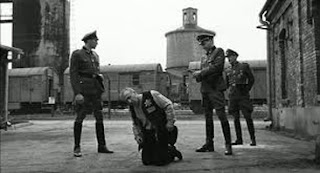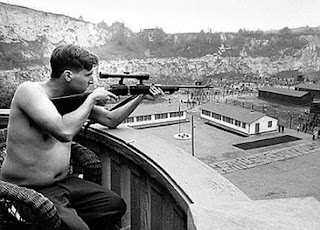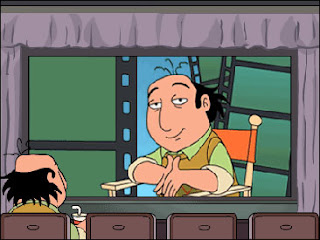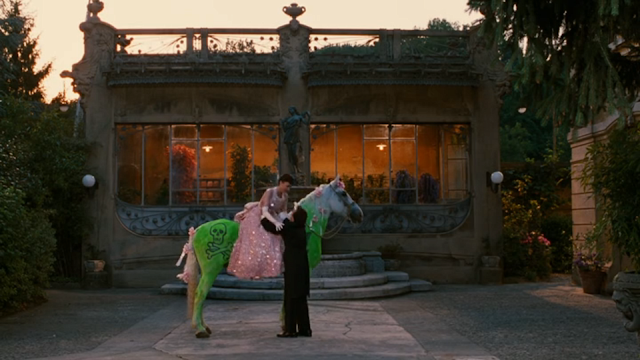Schindler's List
The creation of Schindler's List started with Poldek Pfefferberg, a holocaust survivor who persistently pushed for Oskar Schindler's story to be told on film. His efforts began very shortly after the war, but the fruits of his constancy did not take shape until 1980, when the Austrian novelist Thomas Keneally agreed to write the book Schindler's Ark. After it was published in 1982, Pfefferberg began pushing the idea of a film once again, but this time to Steven Spielberg. It would take 11 years before Spielberg felt capable of tackling the subject matter, but the result of Pfefferberg's tenacity paid off.
The scope of Schindler's List is so vast that a book could be written about it in the name of critical analytics. This is not only a great film, but an important one. Every decision made during its inception has culminated into a brilliant masterpiece, and it is not insignificant that Spielberg won his first Oscar for this film. Several decisions were made by the director that would not only go against the typical way in which he made a film, but agains the Hollywood norm as well. This is difficult to accomplish, even for a man of Spielberg's clout. Many were worried upon hearing of Spielberg's decision to make a Holocaust film, in that he would create a glossy Hollywood movie and undermine the events. However, this did not end up being the case. Shooting in black and white, using hand held, and the absence of the crane and Steadicam were all choices that culminated into something almost anti-Hollywood. Spielberg himself did not think the film would do well.
The use of symbolism was also included in addition to the aforementioned changes to Spielberg's style. There's never anything below the surface of what you're watching in the typical Spielberg fare. Schindler's List makes an exception. While symbolism is held to a minimum, occurring only once with the infamous "girl in the red coat", credited in the film as Red Genia, it serves a large purpose with multiple layers. Spielberg's explanation of her color choice was explained on AMC's Imagery Witness: Hollywood and the Holocaust when he stated:
"America and Russia and England all knew about the Holocaust when it was happening, and yet we did nothing about it. We didn't assign any of our forces to stopping the march toward death, the inexorable march toward death. It was a large bloodstain, primary red color on everyone's radar, but no one did anything about it. And that's why I wanted to bring the color red in."
There is another reason for the decision of Red Genia's coat breaking the pallet of black and white -- one of recognition and change. IGN's Andy Patrizio explains after Schindler sees her coat on the cart, "The look on Schindler's face is unmistakable. Minutes earlier, he saw the ash and soot of burning corpses piling up on his car as just an annoyance." One could argue that the color takes you out of the film, making you realize you're watching something that isn't real. However, I argue that a film such as this, boldly attempting to express a message of immense magnitude, uses a splash of blood red not stop our willing suspension of disbelief, but to pull us in, make us sit up straight and say, "What's that? Who is she?" Without a single word or action outside of walking through a violent street, we the audience have suddenly become attached and sympathetic to a small girl in the ghetto. We are therefore all the more saddened by her death, noted only by her coat on a cart.
The fact that Spielberg decided to shoot in black and white did not go over well with the studio. Universal chairman Tom Pollock preferred Spielberg shoot in color and do black and white in post, allowing them to release a colored version on VHS. Spielberg has famously refused by saying he did not want "to beautify events". You can also observe how the imagery appears to mirror everything we have seen from actual footage of the Holocaust. For the viewer this can make the experience all the more real and immersing. Hand held shots were used in just less than half of the film, also making the movie feel as though we are watching the documentary footage we have all seen. Spielberg opted not to use storyboards for this reason, in order to have a sense of spontaneity and realism.
The crane and Steadicam are often used to create that Hollywood look we have come to recognize, and they have been included in every Spielberg film up to this point. He is practically responsible for there overuse today. Spielberg wasn't just taking a risk by excluding them, he was, for the first time in his career, becoming a different director. He grew up as a result of this movie. Gone are the days of Spielberg's fantasy and adventure films. Remember Jurassic Park and Hook? The 15 years following Schindler's List would result in Spielberg directing 10 films. Only three of those could be considered his typical fantasy movies -- The Lost World, A.I., and Indiana Jones 4. The rest of his filmography looks like that of Amistad, Saving Private Ryan, and Munich. Even his action films have been affected by his experience on Schindler's List. Minority Report and War of the Worlds both have messages larger than their subject matter of explosions and special effects.
In 1998 Judy Gerstel said it best in the Toronto Star while reviewing The Lost World when she wrote, "after Schindler's List (1993), the filmmaker's sensibility seems to have matured and switched gears." Even Spielberg agrees that at one point he would not have made Schindler's List the movie that it is today. This was most prevalent in a Washington Post article titled "The Man at the Top of 'Schindler's List'" when he said, "I would have had much more drama if I had made this picture when I first bought the book in '82. I would have looked for the drama instead of the reporting of the facts. I would have been looking more for the histrionics." To be blunt, the skeptics were right, but only if Spielberg had made this film a few years earlier. So what does this mean in context to the film? It means that Spielberg's story revolves around facts, not drama. No where is this more important than when examining the Amon Göth criticism.
Many critics, and not just film critics, have been disappointed in Spielberg's making Schutzstaffel (SS) officer Amon Göth too much of a psychopath, believing it created an excuse for Nazism. Had Göth been more relatable, it is arguable that Nazism in the film would appear as an act of choice, and therefore all the more barbaric. Ralph Fiennes said in the TIME magazine article "The Man Behind the Monster", "I got close to his pain. Inside him is a fractured, miserable human being." Perhaps here is a way of humanizing the character. In defense of Spielberg, Göth was a real person. There would be criticism had he not portrayed Göth as the character of true events. The same article in TIME explained Fiennes' likeness to Göth was so believable that a survivor of the events, Mila Pfefferberg, trembled with fear upon seeing him. Truly the man represented was nothing less than a monster, and he was rightly portrayed.
For Spielberg it was not about how characters interacted as much as it was about the truth. Schindler's List is 195 minutes long, that's 3 and a quarter hours for those doing the math. Surely no film running 195 minutes can tell the story of the Holocaust. This makes it all the more important to tell the facts and not dramatize any events. Nobody thought a Holocaust film could be successful, and this is the greatest reason for the success of Schindler's List. Not even Spielberg expected it to make any money. He was free, in a sense, to make the movie he needed to make, and not what anyone thought might make a financial success.
Attempting to make a film about the Holocaust not only seems impossible, it is impossible. Claude Lanzmann made an astonishing effort with his documentary Shoah, but it's 9 hour running time prevents it from being watchable by the typical moviegoer. Herein lies the problem. What then does a movie of this subject matter intend on doing? It is in my opinion that a movie on the Holocaust should do the following: inform, preserve, and be watchable. A 9 hour motion picture on any subject does not reach but a few small audiences, and therefore fails to reach the world with its message. Therefore it must be contained within the prospect of a reasonable time frame, and Spielberg does that with his movie. Of course he can't say everything, and he shouldn't have to. This movie informs us of things we might have forgotten, and therefore preserves the tragedy in a watchable way for billions of people, including the Germans themselves. In the Washington Post article Spielberg said:
"I felt a kind of ignorance about the Holocaust from rank-and-file Poles. It's not taught in schools, not gossiped about. There was no curiosity about it. The curiosity was that we were bringing money to a bad economy. There was great curiosity about 'How can we be involved?' … I received so many apologies from Germans playing Nazis," Spielberg says. "I don't know any of them who didn't at one point in the filming come over to apologize to me for what happened: 'I'm sorry for what my father did, I'm sorry for what my grandfather did … I'm sorry' was said so many times by young Germans playing Nazis in this movie. They even said it on tapes made for the casting. It was incredible the atonement that was going on just in the casting of this movie in Germany."
That is the most important aspect of this movie. It has taught, is teaching, and will continue to teach people about what really happened. We are already experiencing a sense of denial in the world about the Holocaust, and I can only imagine what would have happened in a world without Schindler's List.









I asked, and you delivered. It is one of my all time favorite movies only because of how emotionally moved and spent I felt after viewing it for the first time. As I read your critique I'm moved even further as I realize I only scratched the surface of some of what the film had to offer. This isn't what I expected. Not at all. I thought I would find a gloss over of how you felt after your viewing never expecting something so deep. An approach from an understanding of the director and the culmination of all he put into the film. The research and the seriousness of what you've invested into the critique only proves your dedication to what I feel will lead to a long successful life and career. Icing on the cake would have been talking about it over a cup of coffee and breakfast.
ReplyDeleteThanks for the critique…
Love, Dad